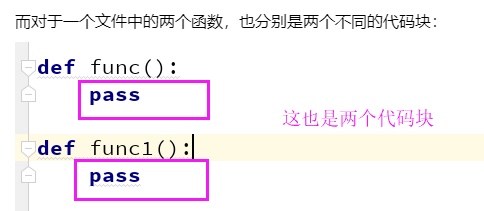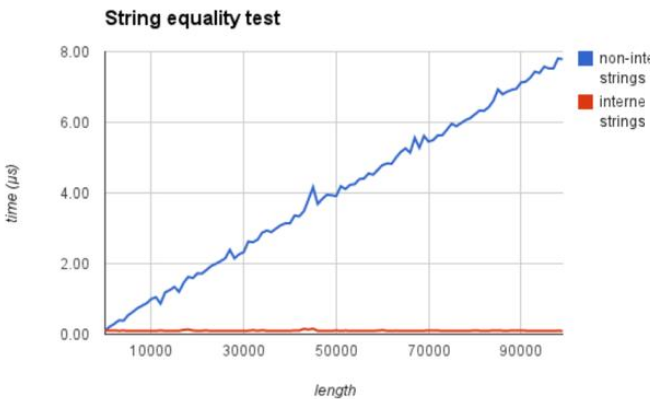python小数据池、代码块1
python小数据池、代码块
1、id is ==
在Python中,id是什么?id是内存地址,比如你利用id()内置函数去查询一个数据的内存地址:
name = '太白' print(id(name)) # 1585831283968
== 是比较的两边的数值是否相等
is 是比较的两边的内存地址是否相等。 如果内存地址相等,那么这两边其实是指向同一个内存地址。

可以说如果内存地址相同,那么值肯定相同,但是如果值相同,内存地址不一定相同
2、代码块
1、官方解释:

A Python program is constructed from code blocks. A block is a piece of Python program text that is executed as a unit. The following are blocks: a module, a function body, and a class definition. Each command typed interactively is a block. A script file (a file given as standard input to the interpreter or specified as a command line argument to the interpreter) is a code block. A script command (a command specified on the interpreter command line with the ‘-c‘ option) is a code block. The string argument passed to the built-in functions eval() and exec() is a code block. A code block is executed in an execution frame. A frame contains some administrative information (used for debugging) and determines where and how execution continues after the code block’s execution has completed.
解读:
Python程序是由代码块构造的。块是一个python程序的文本,他是作为一个单元执行的。
代码块:一个模块,一个函数,一个类,一个文件等都是一个代码块。
而作为交互方式输入的每个命令都是一个代码块。


2、代码块的缓冲机制:
Python在执行同一个代码块的初始化对象的命令时,会检查是否其值是否已经存在,如果存在,会将其重用。换句话说:执行同一个代码块时,遇到初始化对象的命令时,他会将初始化的这个变量与值存储在一个字典中,在遇到新的变量时,会先在字典中查询记录,如果有同样的记录那么它会重复使用这个字典中的之前的这个值。所以在你给出的例子中,文件执行时(同一个代码块)会把i1、i2两个变量指向同一个对象,满足缓存机制则他们在内存中只存在一个,即:id相同。
代码块的缓存机制的适用范围: int(float),str,bool。
int(float):任何数字在同一代码块下都会复用。
bool:True和False在字典中会以1,0方式存在,并且复用。
str:几乎所有的字符串都会符合缓存机制,具体规定如下(了解即可!):
1、非乘法得到的字符串都满足代码块的缓存机制:
s1 = '太白@!#*ewq' s2 = '太白@!#*ewq' print(s1 is s2) # True
2、乘法得到的字符串分两种情况:
1)乘数为1时,任何字符串满足代码块的缓存机制:
b1 = '太白@5847395QQ0743895*&^%$#((&_+(())' *1 a1 = '太白@5847395QQ0743895*&^%$#((&_+(())' *1 print(a1 is b1) # Tru
2)乘数>=2时:仅含大小写字母,数字,下划线,总长度<=20,满足代码块的缓存机制:
s1 = 'old_' * 5 s2 = 'old_' * 5 print(s1 is s2) # True
优点:
1、能够提高一些字符串,整数处理人物在时间和空间上的性能;
2、需要值相同的字符串,整数的时候,直接从‘字典’中取出复用,避免频繁的创建和销毁,提升效率,节约内存
3、小数据池
小数据池,也称为小整数缓存机制,或者称为驻留机制等等。
针对对象:
int bool str ()空元组(小数据池是针对不同代码块之间的缓存机制)
官方解释

对于整数,Python官方文档中这么说: The current implementation keeps an array of integer objects for all integers between -5 and 256, when you create an int in that range you actually just get back a reference to the existing object. So it should be possible to change the value of 1. I suspect the behaviour of Python in this case is undefined. 对于字符串: Incomputer science, string interning is a method of storing only onecopy of each distinct string value, which must be immutable. Interning strings makes some stringprocessing tasks more time- or space-efficient at the cost of requiring moretime when the string is created or interned. The distinct values are stored ina string intern pool. –引自维基百科
中文解释
1、Python自动将-5~256的整数进行了缓存,当你将这些整数赋值给变量时,并不会重新创建对象,而是使用已经创建好的缓存对象。/2、python会将一定规则的字符串在字符串驻留池中,创建一份,当你将这些字符串赋值给变量时,并不会重新创建对象, 而是使用在字符串驻留池中创建好的对象。
其实,无论是缓存还是字符串驻留池,都是python做的一个优化,就是将~5-256的整数,和一定规则的字符串,放在一个‘池’(容器,或者字典)中,无论程序中那些变量指向这些范围内的整数或者字符串,那么他直接在这个‘池’中引用,言外之意,就是内存中之创建一个。
优点:
1、能够提高一些字符串,整数处理人物在时间和空间上的性能;
2、需要值相同的字符串,整数的时候,直接从‘池’里拿来用,避免频繁的创建和销毁,提升效率,节约内存。
int:
那么大家都知道对于整数来说,小数据池的范围是-5~256 ,如果多个变量都是指向同一个(在这个范围内的)数字,他们在内存中指向的都是一个内存地址。

str
1,字符串的长度为0或者1,默认都采用了驻留机制(小数据池)。


2,字符串的长度>1,且只含有大小写字母,数字,下划线时,才会默认驻留。

3,用乘法得到的字符串,分两种情况。
3.1 乘数为1时:
仅含大小写字母,数字,下划线,默认驻留。

含其他字符,长度<=1,默认驻留。

含其他字符,长度>1,默认驻留。

3.2 乘数>=2时:
仅含大小写字母,数字,下划线,总长度<=20,默认驻留。

4,指定驻留。
from sys import intern
a = intern('hello!@'*20)
b = intern('hello!@'*20)
print(a is b)
#指定驻留是你可以指定任意的字符串加入到小数据池中,让其只在内存中创建一个对象,多个变量都是指向这一个字符串。
满足以上字符串的规则时,就符合小数据池的概念。
bool
True,False,无论你创建多少个变量指向True,False,那么他在内存中只存在一个。

4、小结
如果在同一代码块下,则采用同一代码块下的换缓存机制。
如果是不同代码块,则采用小数据池的驻留机制。
# pycharm 通过运行文件的方式执行下列代码: 这是在同一个文件下也就是同一代码块下,采用同一代码块下的缓存机制。 i1 = 1000 i2 = 1000 print(i1 is i2) # 结果为True 因为代码块下的缓存机制适用于所有数字
通过交互方式中执行下面代码: # 这是不同代码块下,则采用小数据池的驻留机制。 >>> i1 = 1000 >>> i2 = 1000 >>> print(i1 is i2) False # 不同代码块下的小数据池驻留机制 数字的范围只是-5~256.
更多验证:
# 虽然在同一个文件中,但是函数本身就是代码块,所以这是在两个不同的代码块下,不满足小数据池(驻存机制),则指向两个不同的地址。 def func(): i1 = 1000 print(id(i1)) # 2288555806672 def func2(): i1 = 1000 print(id(i1)) # 2288557317392 func() func2()
相关连接:
https://zhidao.baidu.com/question/494120409773699052.html
http://mini.eastday.com/bdmip/180405084648167.html


